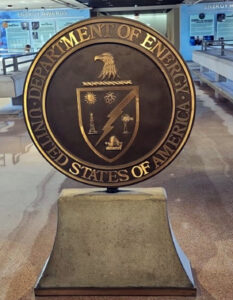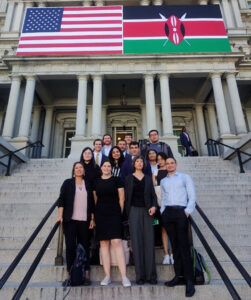Navigating the Complexities of U.S. Science Policy
By Gabriel Vega Bellido and Aria Zhang
Dept. of Materials Science & Engineering, University of Pennsylvania
NRT Soft AE Trainees
Published June 3, 2024
We had the enriching opportunity to delve into the U.S. science policy landscape during the Science Outside the Lab – Energy (SOtL-Energy) Workshop, which was an intensive program held over five full days (May 20-24, 2024). SOtL-Energy was created through a partnership between Penn’s NRT Soft AE Program, the Penn Kleinman Center for Energy Policy and the Consortium for Science, Policy & Outcomes (CSPO) at Arizona State University (ASU). Any graduate student at the University of Pennsylvania interested in learning more about energy-related science policy was invited to apply to SOtL-Energy. This first cohort included first-year Master’s and PhD students to 5th-year PhD students in both STEM and non-STEM degree programs at Penn. The faculty lead for SOtL-Energy 2024 was the impressively passionate ASU Prof. Jennifer Richter, whose expertise includes energy transitions and nuclear waste storage. The teaching assistant was Ben Shindel, who is finishing his PhD work on materials for environmental remediation at Northwestern University in the Materials Science and Engineering Department and who previously participated in ASU’s 2023 SOtL-Nano Workshop.
 Given the focus of this SOtL-Energy, we met a variety of people working for the Department of Energy in the Office of Clean Energy Development, the Office of Technology Transitions, the Solar Energy Technologies Office, the Wind Technologies Office, the Office of Clean Energy Demonstrations, and the Office of Basic Energy Sciences. We also met people working in CSPO, the Environmental Protection Agency (EPA), the Office of Science and Technology Policy, the Government Accountability Office, the Department of the Navy, and the National Nanotechnology Coordinating Office. Our meetings took place either at the ASU-D.C. Building or at the speakers’ agency or offices. We also had scheduled visits to the National Museum of American History and the National Museum of the American Indian, and we spent a morning at the American Solar Energy Society’s Solar 2024 Connecting Technology & Policy Conference. Our visit to Washington D.C. shed light on the intricate web of agencies responsible for funding, regulating, executing, and coordinating the U.S. government’s science policy agenda. The current situations were put into the context of their histories and hoped futures.
Given the focus of this SOtL-Energy, we met a variety of people working for the Department of Energy in the Office of Clean Energy Development, the Office of Technology Transitions, the Solar Energy Technologies Office, the Wind Technologies Office, the Office of Clean Energy Demonstrations, and the Office of Basic Energy Sciences. We also met people working in CSPO, the Environmental Protection Agency (EPA), the Office of Science and Technology Policy, the Government Accountability Office, the Department of the Navy, and the National Nanotechnology Coordinating Office. Our meetings took place either at the ASU-D.C. Building or at the speakers’ agency or offices. We also had scheduled visits to the National Museum of American History and the National Museum of the American Indian, and we spent a morning at the American Solar Energy Society’s Solar 2024 Connecting Technology & Policy Conference. Our visit to Washington D.C. shed light on the intricate web of agencies responsible for funding, regulating, executing, and coordinating the U.S. government’s science policy agenda. The current situations were put into the context of their histories and hoped futures.
“The US Government is dysfunctional on purpose” was the comment of one panelist, pointing to the complex system of checks and balances, which are intrinsic to the US’ democracy. This structure is particularly evident in the realm of science policy, where priorities set by the President are checked by Congress through its control of the government’s budget and executed by various agencies within the Executive Branch. This dynamic interplay was described by another speaker as a “team-contact sport.” Unlike the often-straightforward analytical world of science and engineering, science policy involves navigating a maze of competing interests with no clear solutions, only progressively better compromises.
An illustrative example of this is the Yucca Mountain project in Nevada. Designated in 1987 as the long-term nuclear waste repository for the nation’s spent nuclear fuels and other high-level radioactive waste, the project saw over $9 billion spent on geological and materials science studies. Despite this investment, opposition from public groups, tribal nations, and the state of Nevada led to the project never being completed. Work on long-term nuclear waste disposal continues, but learning from the past, recent administrations have adopted a more consent-based approach in the siting process. In contrast, some other government projects have been remarkably successful while ruffling fewer feathers, such as the voluntary EPA-sponsored Energy Star program. As a voluntary public-private partnership aimed at increasing building energy efficiency and reducing greenhouse gas emissions through the adoption of better building practices and efficient modern appliances, this program has saved an estimated $500 billion in energy costs and cut emissions by 4 billion metric tons since 1992. These examples illustrate to us that although the government’s approach to science policy might lack in efficiency, it makes up for this by seeking to guard the public interest.
Overall, the workshop provided us with a comprehensive understanding of the complexities of U.S. science policy.


